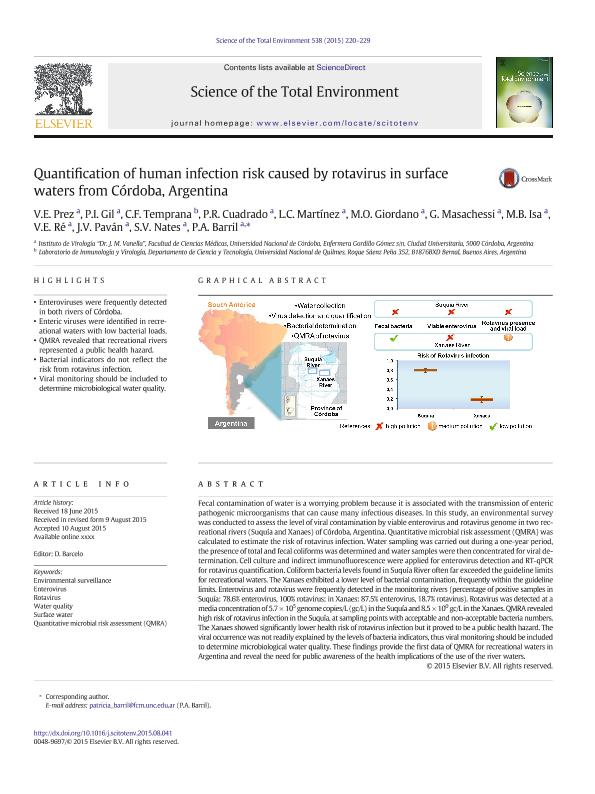Artículo
Quantification of human infection risk caused by rotavirus in surface waters from Córdoba, Argentina
Prez, Verónica Emilse ; Gil, Pedro Ignacio; Temprana, Carlos Facundo
; Gil, Pedro Ignacio; Temprana, Carlos Facundo ; Cuadrado, P. R.; Martínez, L.C.; Giordano, Miguel Oscar; Masachessi, Gisela
; Cuadrado, P. R.; Martínez, L.C.; Giordano, Miguel Oscar; Masachessi, Gisela ; Isa, Maria Beatriz; Ré, Viviana Elizabeth
; Isa, Maria Beatriz; Ré, Viviana Elizabeth ; Pavan, Jorge Victorio; Nates, Silvia Viviana; Barril, Patricia Angelica
; Pavan, Jorge Victorio; Nates, Silvia Viviana; Barril, Patricia Angelica
 ; Gil, Pedro Ignacio; Temprana, Carlos Facundo
; Gil, Pedro Ignacio; Temprana, Carlos Facundo ; Cuadrado, P. R.; Martínez, L.C.; Giordano, Miguel Oscar; Masachessi, Gisela
; Cuadrado, P. R.; Martínez, L.C.; Giordano, Miguel Oscar; Masachessi, Gisela ; Isa, Maria Beatriz; Ré, Viviana Elizabeth
; Isa, Maria Beatriz; Ré, Viviana Elizabeth ; Pavan, Jorge Victorio; Nates, Silvia Viviana; Barril, Patricia Angelica
; Pavan, Jorge Victorio; Nates, Silvia Viviana; Barril, Patricia Angelica
Fecha de publicación:
12/2015
Editorial:
Elsevier Science
Revista:
The Science Of Total Environment
ISSN:
0048-9697
Idioma:
Inglés
Tipo de recurso:
Artículo publicado
Clasificación temática:
Resumen
Fecal contamination of water is a worrying problem because it is associated with the transmission of enteric pathogenic microorganisms that can cause many infectious diseases. In this study, an environmental survey was conducted to assess the level of viral contamination by viable enterovirus and rotavirus genome in two recreational rivers (Suquía and Xanaes) of Córdoba, Argentina. Quantitative microbial risk assessment (QMRA) was calculated to estimate the risk of rotavirus infection. Water sampling was carried out during a one-year period, the presence of total and fecal coliforms was determined and water samples were then concentrated for viral determination. Cell culture and indirect immunofluorescence were applied for enterovirus detection and RT-qPCR for rotavirus quantification. Coliform bacteria levels found in Suquía River often far exceeded the guideline limits for recreational waters. The Xanaes exhibited a lower level of bacterial contamination, frequently within the guideline limits. Enterovirus and rotavirus were frequently detected in the monitoring rivers (percentage of positive samples in Suquía: 78.6% enterovirus, 100% rotavirus; in Xanaes: 87.5% enterovirus, 18.7% rotavirus). Rotavirus was detected at a media concentration of 5.7 × 105 genome copies/L (gc/L) in the Suquía and 8.5 × 100 gc/L in the Xanaes. QMRA revealed high risk of rotavirus infection in the Suquía, at sampling points with acceptable and non-acceptable bacteria numbers. The Xanaes showed significantly lower health risk of rotavirus infection but it proved to be a public health hazard. The viral occurrence was not readily explained by the levels of bacteria indicators, thus viral monitoring should be included to determine microbiological water quality. These findings provide the first data of QMRA for recreational waters in Argentina and reveal the need for public awareness of the health implications of the use of the river waters.
Archivos asociados
Licencia
Identificadores
Colecciones
Articulos(CCT - CORDOBA)
Articulos de CTRO.CIENTIFICO TECNOL.CONICET - CORDOBA
Articulos de CTRO.CIENTIFICO TECNOL.CONICET - CORDOBA
Articulos(CCT - PATAGONIA NORTE)
Articulos de CTRO.CIENTIFICO TECNOL.CONICET - PATAGONIA NORTE
Articulos de CTRO.CIENTIFICO TECNOL.CONICET - PATAGONIA NORTE
Articulos(SEDE CENTRAL)
Articulos de SEDE CENTRAL
Articulos de SEDE CENTRAL
Citación
Prez, Verónica Emilse; Gil, Pedro Ignacio; Temprana, Carlos Facundo; Cuadrado, P. R.; Martínez, L.C.; et al.; Quantification of human infection risk caused by rotavirus in surface waters from Córdoba, Argentina; Elsevier Science; The Science Of Total Environment; 538; 12-2015; 220-229
Compartir
Altmétricas



